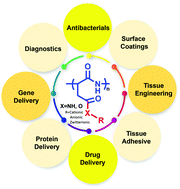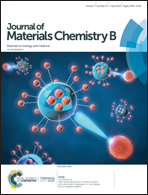Emerging biomedical applications of polyaspartic acid-derived biodegradable polyelectrolytes and polyelectrolyte complexes
Abstract
Polyelectrolytes (PELs) – polymers with charged repeat units – have emerged as a useful class of polymers for biomedical applications due to their high aqueous solubility, low aggregation propensity and the opportunity they afford for polyvalent interactions with surfaces. Biodegradability and biocompatibility of PELs are important prerequisites for their utilization in in vivo applications. PELs that can be chemically functionalized with ease prove advantageous for creating diverse biomaterials. Polyaspartic acid (PASA) is a modular and biocompatible synthetic PEL that has all these features. It also shows many positive biomedical attributes such as bone-tissue targeting, muco-adhesive behavior and extended blood circulation time. Cationic PELs derived from PASA are rapidly internalized by mammalian and bacterial cells, and hence have immense utility in therapeutic delivery applications. Polyelectrolyte complexes (PECs) and multilayers (PEMs) formed from PASA PELs have further expanded their biomedical utility. This mini-review highlights some recent literature examples of unique biomedical applications of PELs, PECs and PEMs prepared through the molecular engineering of PASA. It discusses biomineralization modulators, anti-mycobacterial agents, underwater adhesives, mucoadhesive drug and gene delivery agents, and cell encapsulants fabricated using PASA derived PELs.



 Please wait while we load your content...
Please wait while we load your content...